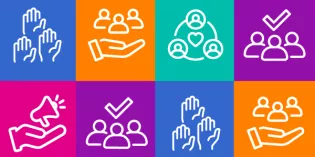
Introduction
Winter is a time of increased demand for acute paediatrics and emergency care. If there is a second surge of COVID-19 cases, we cannot look to disrupt children’s health services and redeploy the paediatric workforce in the same manner as phase 1.
We do not underestimate the challenge involved in tackling the pandemic alongside the provision of other health services. This is not a question of pitting the rights of one group against another. Rather it is a call to recognise and address the risks of limiting access to services for the health of children and young people, both now and in the longer term.
Without prompt attention to restore children’s health services and the workforce that delivers them, and to protect them from surge policies over the next few months, there is a real risk that current health inequalities1 will widen, vulnerable children will slip through the net, the burden of child ill-health and disease will grow and long term damage to workforce development and service innovation. Meeting children’s rights to access the healthcare they need cannot be deferred further.
Background
COVID measures in phase 1 of the pandemic severely constrained the delivery of children’s health services across the UK. Many services were paused, and paediatric space and workforce was redeployed to support national escalation plans to treat the surge in coronavirus cases. This meant that:
- Community paediatrics was unable to function at full capacity, as up to 46% of community trainees were redeployed to acute paediatric care2 and children with complex needs were unable to access regular care.
- Space for paediatric outpatient clinics was redeployed, limiting outpatient care for children with long term conditions.
- Paediatric surgery experienced a huge decrease in the numbers of routine clinical procedures during the outbreak, from 10,000 per week to 330 per week at the height of the pandemic.3
- Access to dental services has been severely constrained.
- Closure of schools meant lack of access to planned vaccinations, such as human papillomavirus (HPV).
- Education and training pathways for paediatric workforce were disrupted and delayed.
There have been further consequences for other children’s health services, with delays observed to diagnosis, referral and treatment, such as:
- reported delays in presentations of child protection cases, despite the increased risk of non-accidental injuries for children4
- reduction in referrals for cancer assessment, raising concerns about undiagnosed cancer and late presentations
- 32% of emergency department paediatricians had witnessed delayed presentations in conditions such as diabetes mellitus (new diagnosis/diabetic ketoacidosis), sepsis and new cancer diagnoses5
- some concern about childhood immunisation rates, especially for the measles-mumps-rubella (MMR) vaccine at one year of age, raising concerns of future outbreaks.6
In addition to a backlog of care, lockdown measures have increased demand for children’s health services, particularly mental health, due to the stresses associated with prolonged school closures, social isolation and adverse social and environmental circumstances. We expect a growth in demand for services, as mental health of children and young people with pre-existing mental health difficulties may have worsened alongside emergence of supressed routine demand from reduction in referrals during the lockdown period, with eating disorders a particular area of concern.7, 8
As winter is a time of increased demand for acute paediatrics and emergency care, a surge in COVID-19 cases cannot be approached in the same manner as in phase 1 as children’s need for health services is different during the winter:
- Demand for children’s health services is particularly acute in autumn and winter, as incidence of respiratory conditions drives demand for urgent and emergency care, and inpatient services, including paediatric intensive care.
- In previous winters we know that this can pose specific risks to children’s health services, as paediatric space and resources in emergency departments have been reallocated to provide adult care under surge and escalation policies.9
- COVID-19 will add another dimension this winter to the usual seasonal respiratory virus pattern from rhinoviruses, influenza and RSV.
- While phase 1 of the pandemic was able to redeploy staff and space from emergency and acute paediatrics, this option will not be readily available during this autumn and winter. We need a different approach.
What we want
The research evidence10 indicates that children do not transmit COVID-19 to the same extent as adults, so the risks associated with restarting children’s health services during the pandemic outweigh the risks to children and young people, and to staff, of restarting. This should allow us to reset and recover scheduled paediatric services through the autumn and winter.
We need to restore and recover children’s health services and the paediatric workforce across all settings, not just because of the direct benefits this brings to children and their families, but the wider support that services offer for a return to school.
Once restored, children’s health services need to be retained throughout the winter. As well as catching up on lost episodes of care arising from lockdown and tackling the legacy of effects on those with long term conditions, we need to prepare for an increased in demand for urgent and emergency care this winter – so we should protect resources to allow these aims to be met as far as possible, to avoid further risks to children’s health.
This means that we need a different approach to surge and escalation policies, one that protects children’s health services and the paediatric workforce, so ongoing needs for care and treatment are met throughout the winter. This approach should be adopted in recovery and winter planning across all children’s health services - urgent and emergency care, acute and community services, mental health and public health.
As well as tackling the backlog of care and health inequalities, and helping to protect vulnerable children, securing the restoration and retention of children’s health services will also help to:
- embed new ways of working and deliver integrated care
- respond to changes in health seeking behaviour by children and parents
- minimise the impact on paediatric training, and
- maximise the effect of the resources available.
What children and young people have said
Children and young people have been sharing their views on their experiences through lockdown but also looking to the future and how health services will support their needs.11
Reset contact, connections and interactions with patients. Think about if it should be in person or virtually, and how to make sure it stays private, confidential, accessible, equal and fair to all children and young people regardless of their background, needs or family. Services should also rethink how they communicate with children, young people and their families, so that we know how and when to access health services during winter and through the pandemic.
Restore access to mental health services and make sure there is enough support for those who need it because of lockdown and COVID-19. It’s much better for us to have mental health support in person so that we can feel we can talk to you in private without family listening in, WiFi going off or not being able to see you properly. Please also check what services are available in local areas for family support for all child health needs, so that we can be helped to get help if we need it.
Recover - help us and our families to have a safe and healthy life, to have good support for long term conditions and to have aspirations for our future again.
Policy recommendations
Building on RCPCH's principles for recovery, we make the following recommendations for policy makers and service leaders.
1. Provide strategic leadership for children and young people, at all levels of the system, to deliver integrated children’s health services
All national and local health organisations - commissioners, providers, regulators, governments - must identify a strategic lead for children’s health services at executive or board level, with responsibility for sustaining the provision of children’s health services and maintaining care pathways.
Service providers, planners, commissioners and users must take a system-wide view and work together across hospital and community services, primary and secondary care, and paediatrics and general practice to design high quality, safe and effective integrated health services.
2. Restore delivery of children’s health services and recover the paediatric workforce, and sustain these throughout the autumn and winter
Trusts and health boards - working with integrated services and networks in primary care - must restore the space and recover the paediatric workforce needed for children’s health services across community and primary care, urgent and emergency care and inpatient services.
Throughout the autumn and winter, trusts and health boards must ensure that resources for children’s health services are protected from adult surge policies and other escalation processes.
National leaders should support local service providers with tailored advice, guidance and support to ensure children’s health services are restored and delivered.
3. Proposals to reset paediatric services should assess the impact on children’s health, and mitigate the risks to children and young people in the short, medium and long term
Commissioners, service providers, trusts and health boards must ensure children are explicitly considered and included in recovery and winter plans that change how services are provided.
Plans, policies and service modifications for this winter must be specifically tested for impact on children and young people’s health, and in particular on vulnerable children.
Mitigating actions should be identified that minimise any negative effects on children’s health services and the paediatric workforce, including training pathways.
- 1RCPCH. State of Child Health 2020 https://stateofchildhealth.rcpch.ac.uk
- 2RCPCH The impact of COVID-19 on child health services - https://www.rcpch.ac.uk/resources/impact-covid-19-child-health-services…
- 3Academy of Medical Sciences. 2020. Preparing for a challenging winter 2020/2021. Available at: https://acmedsci.ac.uk/file-download/51353957
- 4Who has been missed? Dramatic decrease in numbers of children seen for child protection assessments during the pandemic. https://adc.bmj.com/content/early/2020/06/17/archdischild-2020-319783
- 5Lockdown measures reduced the risk of covid-19, but had unintended consequences for children https://blogs.bmj.com/bmj/2020/08/06/lockdown-measures-reduced-the-risk…
- 6McDonald HI, et al (2020) Early impact of the coronavirus disease (COVID-19) pandemic and physical distancing measures on routine childhood vaccinations in England, January to April 2020. https://www.ncbi.nlm.nih.gov/pmc/articles/PMC7238742/
- 7Lockdown measures reduced the risk of covid-19, but had unintended consequences for children https://blogs.bmj.com/bmj/2020/08/06/lockdown-measures-reduced-the-risk…
- 8Children and Young People’s mental health restoration and recovery planning, NHS England South East Clinical Delivery Network
- 9RCPCH Winter pressures survey 2018. https://www.rcpch.ac.uk/resources/winter-pressures-survey-results-2018
- 10RCPCH COVID-19 research evidence summaries. [Not available as of August 2022]
- 11RCPCH COVID-19 summaries of key findings on children and young people's views. https://www.rcpch.ac.uk/resources/covid-19-summaries-key-findings-child…










